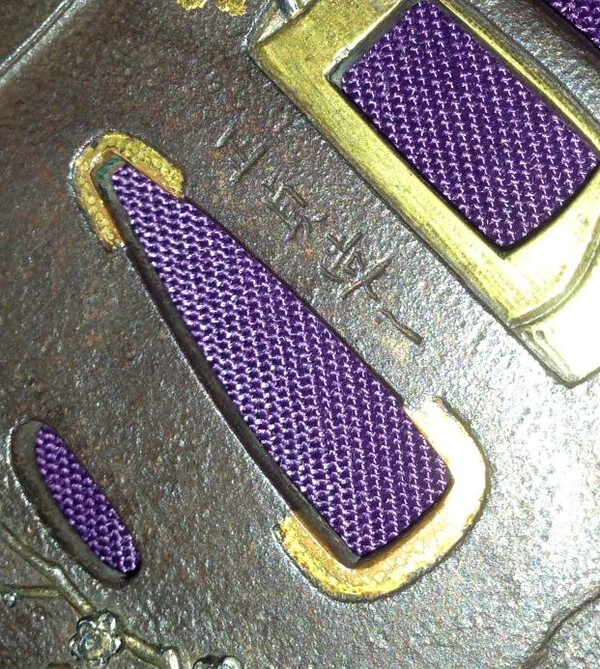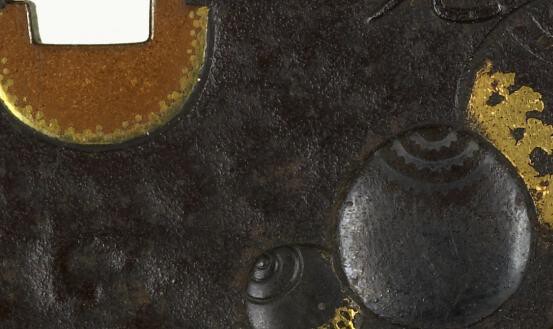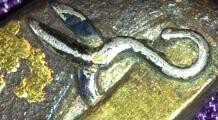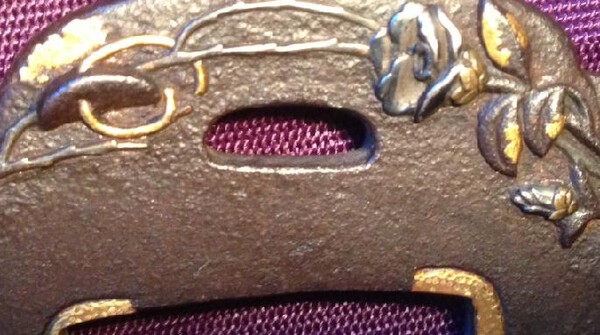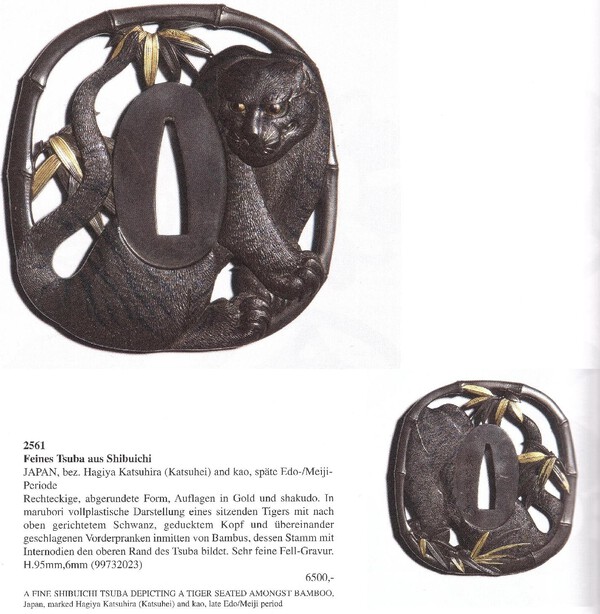
Higo-san
Members-
Posts
707 -
Joined
Content Type
Profiles
Forums
Events
Store
Downloads
Gallery
Everything posted by Higo-san
-
Hi Grey, The tsuba might be bad, but trust me in this point - the sekigane are real inlaid sekigane and if I may add: IMO the inlay is done in a rather nice and accurate way.
-
Thank you for your statements, Mariusz! To be honest, I totally agree with you with regards to quality (and books). The other tsuba, that were taken as reference works, are done in a much higher quality. Nevertheless, I simply wanted to discuss the features of this small tsuba. I do not want to convince anybody that this a treasure find! But I do believe that this tsuba is worth disussing it, since it has some features that are worth a discussion. This is the reason why I try to challenge people into a discussion. I do like the idea that this tsuba was done by some non-trained guy named Masasada (what does the rest of the mei say BTW?) who tried to imitate the style of tanaka. And then - looking at the parts where he failed in - understanding what makes tanaka special. In my opinion you cannot discuss the big names (like Kiyotoshi...) only by seeing photos. You will allways miss something - and this something is what makes them spectacular. A good example are Higo tsuba: If you ever had the oportunity to hold at least two iron Jingobei in hand, you will understand what pictures can never teach you. To come back to this very tsuba: on this tsuba one could (if I were be a more talented photographer...) see everything one needs to see from photos to fully judge the tsuba. And that`s why I wanted to discuss this tsuba and not a Kiyotoshi - besides the fact that I do not own a Kiyotoshi .
-
And a close up of the signature ! Seems a bit like someon did not find the time to finish the signature (with that last stroke being sort of misplaced)...
-
That is a start, Mariusz ! Of course, the tiger is nicely done and costs, for sure, fifteen times more than my tsuba. But if you do compare the way the gold is applied to the leaves beneath the tiger and the way the small twig is done, it reminds me of my tsuba (I have attached another photo; the best I can do with my mobile phone...). Can you see (from the pictures) that the long twig and the flowers body are done by using two different metals and techniques (silver inlay and iron cutting)? IMHO, that makes it too costly and difficult for low quality tourist stuff. I have also attached a close-up of the scissor to show the rubbing effect; it is actually done in three different metals: silver, shakudo and a very small gold plug (where the scissor opens). Also, I have attached a photo of another tanaka piece. It is interesting to see the way the surface was done (completely different than the one posted by Mariusz).
-
At least, the discussion is very interesting. @ Mariusz: Mariusz, can you give reasons for your statement? Please, do not get me wrong! I do not say, you are wrong; but I think one can only learn, if a reason for a statement is given (and I can only evaluate an opinon if a reason is given). May I remind you, that your arguements until now were: "Those "sekigane" serve no purpose. Never seen sekigane painted gold.". Well, then you do not have seen too many tanaka tsuba, I am afraid. Again, no offense to you or your expertise on tsuba, Mariusz! I am just curious about the "why". That is why I am very much with Brian. The reason why I have posted this tsuba is the following: it does not have any NBTHK papers attesting anything to it. It does have some really nice features (like the hammered surface, the gold applied, the way the blossoms are done: did you realize that there is some shakudo layer on top of the silver which has been rubbed away (intentionally?) in order to show the silver that lies beneath it?), but on the other hand there are things like the smaller hitsu ana which does not fit well into the design (and that is really untypical for tanaka). Thanks again for reading and replying to this topic. Please put me in cc when you send those PMs to Brian ! I will not take any offense in criticism. Since Christian has already pointed a gun into my face, I do not think it can become worse )))!
-
BTW: what does that pistol stand for? A cherry blossom that gave someone a heart attack???
-
Thank for your comments so far! The sekigane are made out of copper with dotted gold points on it (I have attached another photo of a tanaka tsuba which shows the very same technique; I am sorry for the bad quality of my photos). And tey are not cast into the plate and then painted. As suggested by Christian, I opened some books and I realized that tanaka sekigane did never ever serve any other prupose than being decoration ! Let`s come back to this litte tsuba: I do think it is tanaka school tsuba. The reasons for this being: - the surface of the iron plate (which has the typical brownish color) is done in a nice way. If you do compare this tsuba to bigger ones done by the tanako school, you will realize that the bigger ones have a fantastic tsujime. Since this little tsuba (only 5 cm in height) does not offer enough space for a extended tsujime, it was done in a smaller way to fit the smaller size. You can see this effect best on the third picture (which actually comes closest to real). - the sekigane are nothing else but average quality tanaka sekigane. - the whole picture is somewhat "framed", which means that the decoration creates a frame (one of the elements, the tanaka school is famous for) and at the very same time the frame is the decoration. - the mei is not imposed; it is carved. But I could only find one other poor resolution picture of another tsuba showing the Masasada mei. Does someone have another reference signature? Adding all those hints together, this one should be a tanaka tsuba. Did I convince at least some of the critics ? I believe it has been made for a kaiken or something very small. The picture itself (a garden scene) also suggests that. But I am happy for other ideas! Maybe someone recognizes this scenery? The discussion also raised another question: how did the tanaka guys do the gold spots on the sekigane? Were they painted?
-
To be honest, I do not get your point about the sekigane. They are neither faked nor unreal. The metal body of the tsuba and the sekigane are two (or rather three) different parts (maybe the thin line between the iron and the copper is not very strong on the pictures, but it is definately there)...
-
-
Dear fellow NMB members, I have recently bought this wonderful little tsuba. I have an opinion on it, of course, but I curious about your opinions! Chris
-
My guess is mid-to late 18th century Hoan due to the design and the - what I believe to see from the photos - Hoan typical tsujime treatment of the surface.
-
Hi David, thank you very much for the hint! Actually I did not want to call it either Bishu or Owari and therefore I called it both ! Because: on the one hand, there are Tsuba traditionally classified as Owari tsuba. But - only judging from pictures - I cannot detect the classical Owari tsuba criteria, e.g. tekkotsu, etc. On the other hand, the signature on the reference tsuba clearly indicates that this tsuba was made in Owari 尾張 (or Bishu 尾州). Therefore I could have either called it a Bishu tsuba (which I have never heard of, especially in terms of Yagyu producing schools) or a Bishu Owari tsuba (what I did). Of course, that might sound a little bit overdone... Best wishes, Chris
-
Hi Jean, a very similiar (signed) tsuba has been sold some weeks ago at Klefisch auction house: http://www.klefisch.com/index.php?page_ ... emid=20037 Therefore your tsuba could be classified as a Owari Bishu tsuba . Beautiful tsuba and sword, by the way... Kind regards, Chris
-
Thank you for the replies so far, gentlemen! By the way, Momoyama Kaga Yoshiro was also my guess. The diameter is 84.00 mm. Thickness is 3.5 mm. Best, Chris
-
Dear Fellow Board Members, I have attached three photos of one of my tsuba. I am happy for comments, opinions and of course kantei. I would also be glad, if someone could help me reading/verifying the signature. Many thanks in advance, Chris
-
Hello lotus, considering the opinions given in the previous posts and taking into consideration the quality of the forgery (from what can be seen on the rim of your tsuba), my - far away from an expert - guess would be Tosa Myochin school. Greetings, Chris
-
You are welcome, gentlemen! Next time I will hopefully be a bit faster . Chris
-
Thank you for the hint, John! Chris
-
First of all, greetings to you, ladies and gentlemen on this board! It is a great honour to be here on the board as a student and collector of tosogu. After having discovered this board it took me some time to go thorugh all the topics and finally I discovered this one. Ford`s utsushi is really stunning and maybe I can add something useful to this topic (in case no one else has added this before): In the first part, Ford mentions that the backside of the original tsuba remains kind of a mistery since the available publication only shows the frontside of the original tsuba. At this point, I remembered an old auction catalogue in my library. The image attached is a scan from the catalogue of "Nagel Auktionen Stuttgart" No. 29A that took place on June 8 2005 in Stuttgart/Germany. I think the original missing tsuba has been sold at this auction. The internet adress of the auction house is http://www.auction.de; I think there is another auction coming in November.




